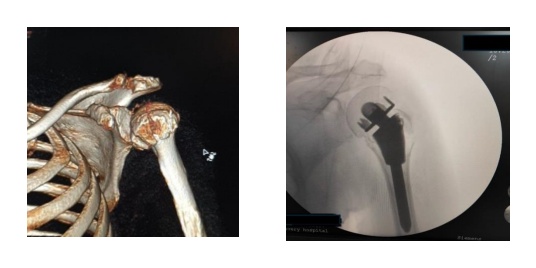Proximal humerus fractures, a frequent occurrence among older individuals with osteoporosis, pose challenges in management. The choice of surgical fixation becomes critical, especially when dealing with factors like fragmented bone and metaphyseal defects. While traditional internal fixation methods have been associated with mechanical failures, a novel approach utilizing Bilboquet type devices offers hope for improved outcomes.
Methods :
At Kauvery Hospital in Chennai, a retrospective study involving 14 patients who underwent Bilboquet fixation for proximal humerus fractures shed light on this innovative technique and its effectiveness. The study focused on Neer 3- and 4-part fractures, excluding cases of head-split fractures. Preoperative assessments, including X-ray and 3D CT scans, were included in gauging the severity of fragmentation and planning the surgical strategy. Preoperative planning with X-ray and 3D CT imaging to assess cortical thickness was an indirect indicator of bone density, thereby evaluating the implant pullout risks.

Image 1 : Complex 4 part fracture of a patient
Image 2 : postop X-ray of bilboquet fixation
Follow up and outcomes:
Outcome measures included imaging assessments, visual analog scale (VAS) scores for pain, range of motion (ROM), functional
assessment tests like Constant scores, and Simple Shoulder Test (SST) scores.
Results from the study showcased promising prospects for Bilboquet fixation. Among the patients, Neer 3-part fractures were predominant, with remaining cases of 4-part fractures. Notably, small metaphyseal bone defects were treated using autografts in select cases. Surgical procedures took an average of 95 minutes, with minimal blood loss with mean amount of 100ml. Postoperative assessment revealed steady progress in range of motion and functional scores, low pain levels with VAS score of 2 reported at the 6-week mark. At 1 year, the mean Constant score was 65, and the mean SST score was 70%. Importantly, complications such as infection or avascular necrosis were not encountered.
The study underscored the importance of patient selection, emphasizing the significance of intact humeral head and minimal fragmentation for optimal outcomes with Bilboquet fixation. This technique offers several advantages, including preservation of native bone, restoration of metaphyseo-cephalic arch, and a reduced risk of mechanical failures. Noteworthy significance is its effectiveness for osteoporosis or metaphyseal bone defects, allowing for early mobilization and good implant purchase. It also offers the possibility of revision to shoulder arthroplasty if needed in future.
In conclusion, Bilboquet fixation represents a significant advancement in the management of complex proximal humerus fractures. Its success lies in its ability to address the unique challenges posed by comminuted fractures and osteoporotic fractures, ultimately offering patients improved mobility and early rehabilitation.



 Mirunaalini Thangavelan
Mirunaalini Thangavelan Dr. Mukunth Krishnamoorthy
Dr. Mukunth Krishnamoorthy Dr. P. Keerthivasan
Dr. P. Keerthivasan